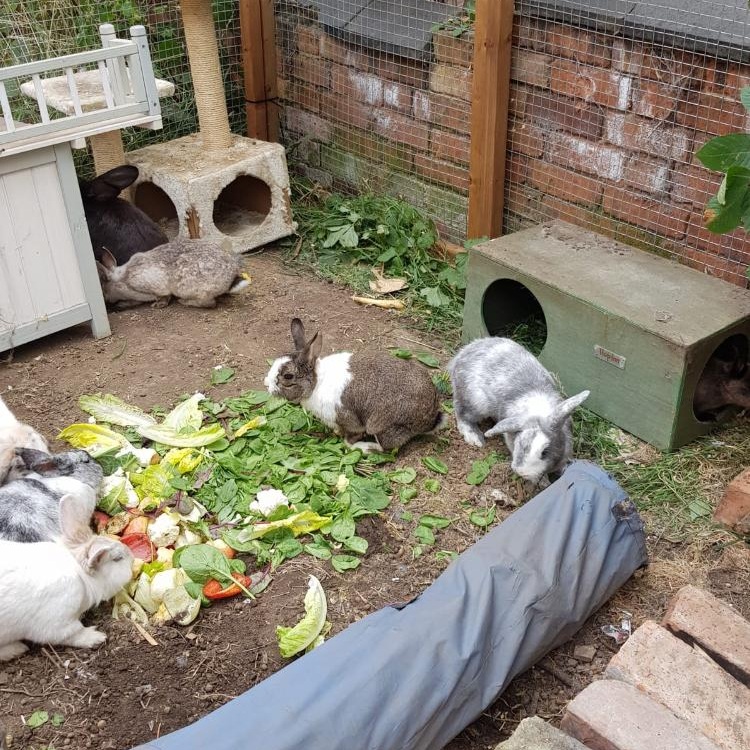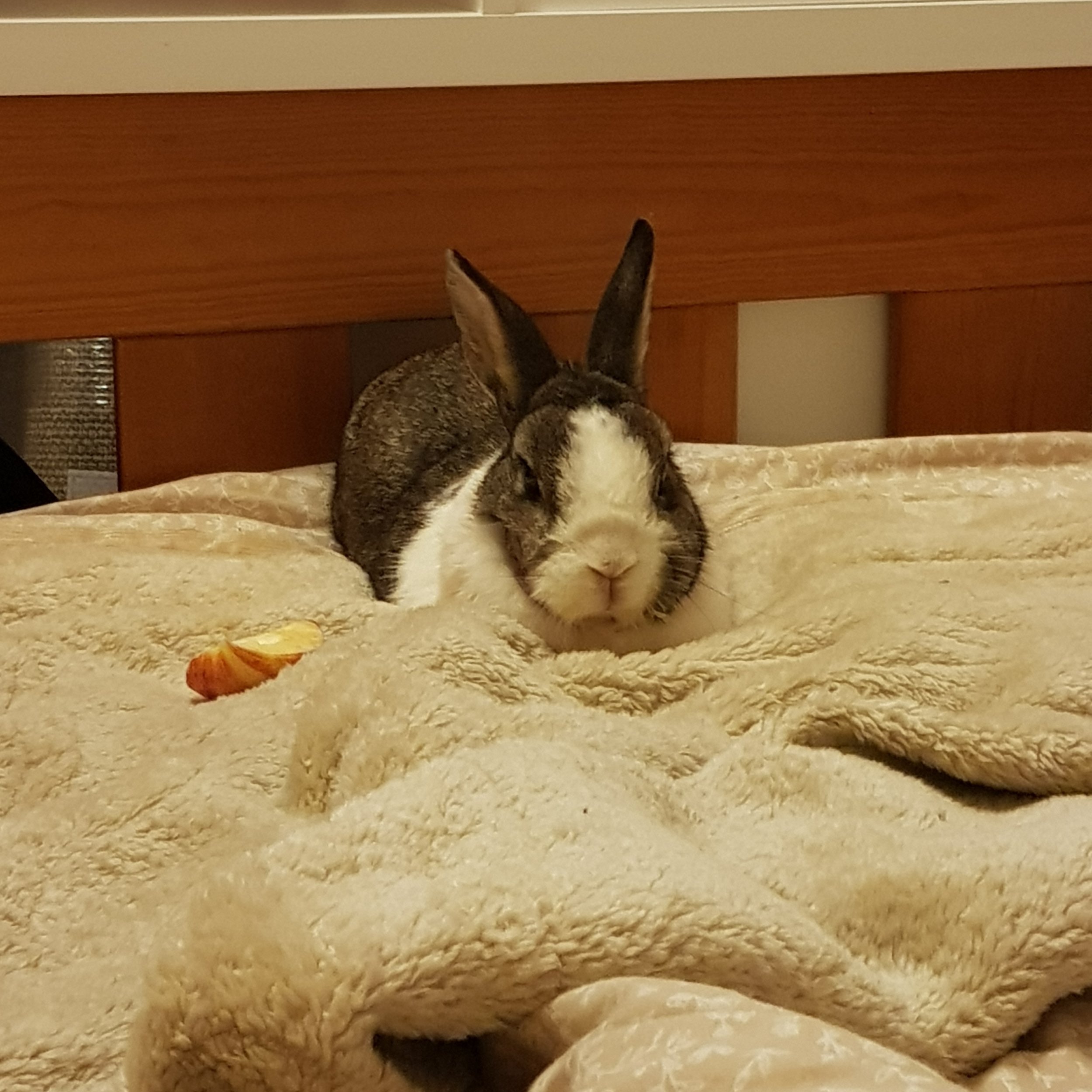Why pellets & nuggets are not part of a healthy diet
Compositional Problems
Commercial pellets, nuggets & museli are full of cheap fillers such as soy-bean hull/meal/oil, these are by-products mainly from the farming industry and are completely unsuitable for the diets of rabbits or guinea-pigs. Prebiotics are added so that the food does not upset the intestinal health, along with enzymes that allow the food (which cannot be digested by the natural intestinal flora), to be digested. Artificial flavours and aromas are additionally added to promote appetite. This means that most animals eat the food with inferior ingredients because the artificial flavours and aromas inhibit their ability to select.
The production of these foods involves the grinding up of all the ingredients which causes the entire structure to be lost. They are then heated, pressed and/or dyed to form shapes. During the heating process any natural vitamins are destroyed which leaves behind a nutrition-less lump of waste material which is then sold to the public as a complete healthy feed.
Tooth Problems
This type of food forces rabbits and guinea-pigs to chew up and down which is an unnatural mouth movement, meaning the back teeth crush rather than grinding and don’t wear down. This is especially important as hay intake is also reduced with pellets, nuggets or museli. In a diet with only a small amount of fresh food (the usual amount most animals receive), the pressure placed on the tooth roots by the up and down chewing motion can cause molar abscesses. These can further lead to the tooth growing back up into the jaw where it can break.
Other Health Problems
The heavily ground short fibres of the food move through the intestines rapidly, meaning that nutrients are not absorbed properly and the small particles can slow the gastrointestinal tract resulting in GI Stasis. They also swell in the stomach meaning that they will stop eating, thinking that they are full. You can test this yourself by placing some of your rabbit or guinea-pigs food in some water and watching to see what happens. Because they stop eating, the food isn’t pushed out by incoming food and this allows the swollen food to ferment causing pain & bloating which can be fatal. Additionally, the PH of the intestinal flora is lowered due to the high concentration of starch and sugar present in the food. This destroys good gut bacteria and allows parasites to take hold such as, Coccidia worms.
Unnecessary additives and massive quantities of synthetic preservatives and vitamins/minerals can have severe consequences such as, kidney problems, bone issues & organ damage leading to sudden death. Vitamin D3 (E671) is a common additive and is actually produced by the ultraviolet irradiation of a chemical extracted from the lanolin found is sheep’s wool. This means that your strict herbivore is ingesting an animal product. There can also be animal oils and fats lurking in the food under the title of ‘tocopherol rich extracts of natural origin.’ Pulped veg described as meal is the leftovers from juice production and is high in starch and sugar with barely any vitamins or minerals. This can cause high blood sugar and malformation of the intestine.
Malnutrition, bladder stones, diarrhea, constipation, fresh food intolerance, hairballs and obesity can also result from this type of diet. Obesity leads to the animal being unable to clean itself properly which increases the risk of flystrike and the amount of weight on the joints can cause osteoarthritis and sore hocks. Heart problems will usually follow.
Factory Farming
This type of food was initially used to fatten rabbits as quickly as possible to get them ready for slaughter to be eaten, without care for the damage it caused. The rabbits never had the chance to show symptoms of fatigue, damage to their digestion or internal organs before they were killed.
Suitable dried food is available in the shop section of this website.
Food Myths
My vet says that the food I use is fine
Most vets are only experienced with dogs and cats and they rely on outdated teachings.
The breeder says that complete dried food is important and that my animal is too young for vegetables yet
Would you keep your animals as a breeder does? So why feed them the same? Young animals actually deal with the switch to the correct diet more easily than older animals as they haven’t had to suffer with the incorrect diet for so long.
My animals love their food
Artificial aromas and flavours trick your animal into eating bad quality food. They are addicted to the food and it is slowly killing them.
My animal is too thin without pellets
Unfortunately most people are used to their animals being overweight due to pellets, nuggets or museli. They also don’t realise the large quantity of food that they need to maintain a healthy weight without these foods. A carrot and a few lettuce leaves every day isn’t going to be enough. Fortunately, there are healthy substitutes which will increase weight such as pea flakes, nuts, seeds & dried veg (not meal).
My animal will selectively feed if I don’t give her complete food and this is unhealthy
Most pellets or nuggets will proudly say that they prevent selective feeding, however, we actually want selective feeding! The ability to select is what keeps animals alive in the wild, they can choose according to their needs on a particular day which prevents many health problems.
Fresh food gives my animal diarrhea
Diarrhea is actually caused by the dry food swelling in the stomach, causing the animal to reduce food intake and any fresh food in the stomach ferments leading to diarrhea.
My animal was healthy it’s whole life, I never had any problems
Most of the damage is internal so will usually go unnoticed, especially as rabbits & guinea-pigs are prey animals so they hide their health problems for as long as possible. This is because in the wild they would be left behind by their group or seen as an easy target by predators. Possible signs are being overweight, lack of movement, having a dewlap (fat roll under the chin), diarrhea, overgrown teeth and a preference for soft foods.
Percy’s Story
Percy was rescued from a single story 120cm x 45cm hutch. He was an unneutered rabbit being kept with an unneutered female guinea-pig named Fudge. He was fed on very little veg and mainly survived on pellets. I got him neutered and whilst he was waiting for the all clear for bonding, he stopped eating hay due to an abscess in the mouth.
He underwent an operation to remove the abscess at the vets but it came back, so he was transferred to a specialist where he had two further operations. He needed these operations because two of his back teeth had retreated down into his jaw where they had broken and he needed them removed. This was due to his diet of pellets growing up. He spent months on antibiotics, pain relief and his open wound where the abscess was draining, was flushed twice a day with hibiscrub whilst he healed.
Percy eventually recovered from his three surgeries (four if you include the neuter), with his abscess finally gone and the wound healed. Unfortunately, he died less than a month later suddenly and without warning. He was only two years old, he barely had a chance to live before his past caught up to him.
Please feed your animals the correct diet.
Sources:
https://www.kaninchenwiese.de/
Arbeitsgemeinschaft fur Wirkstoffe in der Tierernährung eV (ed.): Amino acids in animal nutrition. Bonn: Agrimedia GmbH, 1998
Arbeitsgemeinschaft fur Wirkstoffe in der Tierernährung eV (ed.): Enzymes in animal nutrition. Bonn: Agrimedia GmbH, 2004
Association for Active Ingredients in Animal Nutrition eV (ed.): Probiotics in animal nutrition. Bonn: Agrimedia GmbH, 1999
Association for Active Ingredients in Animal Nutrition eV (ed.): Vitamins in animal nutrition. Bonn: Agrimedia GmbH, 2001
Bell Flavor & Fragrances; http://www.bellff.com/pet-animal-care.html (as of: Dec. 09)
"Pet and Animal Flavors
Consumers increasing concern for the well-being of their animals is expected to expand this already booming industry. [...] "
Beuch-Arendt, A .: Diet of rabbits, guinea pigs, degus and chinchillas, http://www.futterkonzept.de/nagerernaehrungsvortrag.pdf (as of 12 May 09)
Buchmann, M./Geier, U./Strube, J .: Study on changes in food quality through vitaminization
Czitrich, O .: dietary supplement. Meaningful or dangerous? Scientific essay. Books on Demand, 2006
Czitrich, O .: Beware of vitamins. Scientific essay. Books on Demand, 2005
Ewringmann, A .: Leading symptoms in rabbits. Diagnostic Guide and Therapy. Stuttgart: Enke publishing house, 2005
Foodwatch: Lug and trough. The foodwatch report on cheap feeds that cost us dearly. foodwatch Feed Report, April2005
Hand, MS: Clinical Dietetics for Small Animals, Volume 1, 2003
Kaeser, P .: Food additives: classification, function, extraction, composition (lead program), 2004
Kamphues, J .: Rabbits and guinea pigs: Frequent feeding errors and advice on dietetics
Kamphues, J./Coenen, M./Kienzle, E. / Pallauf, J. / Simon, O. / Zentek, J .: Supplements to lectures and exercises in animal nutrition. 10th, revised. Edition. M & H Schaper Verlag, 2004
Kariger, A .: The development of the compound feed industry in Germany. Stuttgart: Kohlhammer publishing house, 1963
Lackenbauer, W .: Rabbit feeding. Humanely. natural. economically. Reutlingen: Oertler + Sporer Verlag, 2001
Meredith, AL, Prebble, JL, & Shaw, DJ (2015). Impact of diet on incisor growth and attrition and the development of dental disease in pet rabbits. Journal of Small Animal Practice.
Prebble, JL, & Meredith, AL (2014). Food and water intake and selective feeding in rabbits on four feeding regimes. Journal of animal physiology and animal nutrition, 98 (5), 991-1000.
Rymon Lipinski, G.-W. von / Lück, E .: Food additives.
Schlolaut, W .: The big book of the rabbit. 3rd revised. Edition. DLG-Verlag GmBH, 2003
Schlolaut, W .: Diet-related disease risks in domestic rabbits, rabbit newspaper 24/2006
Schmidt, E .: Difference between natural and synthetic vitamins
Chudin, A., Clauss, M., Codron, D., Liesegang, A., & Hatt, JM (2011). Water intake in domestic rabbits (Oryctolagus cuniculus) from open dishes and nipple drinkers under different water and feeding regimes. Journal of animal physiology and animal nutrition, 95 (4), 499-511.
Wiesenmüller, W./Leibestseder J .: Nutrition of monogastic farm animals. Gustav Fischer Verlag Jena, 1993
Wolf, P./Kamphues J .: Critical assessment of commercial supplements for rabbits, guinea pigs and chinchillas, 2003
http://www.diebrain.de/nh-index.html
https://www.moehren-sind-orange.de/
Plus, my own experience.





























